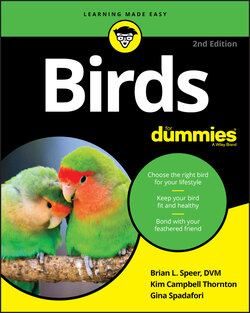Читать книгу Birds For Dummies - Gina Spadafori - Страница 49
Lories and lorikeets
ОглавлениеYou see a lot of lories and lorikeets in zoos and commercial aviaries — their fantastic good looks and clownish personalities are undeniable attractions. They’re a delight to watch, a rainbow of intense, vibrant color. The lory feeding exhibits in many zoos and wildlife parks are popular draws for thousands of people worldwide.
As household pets, though, these guys have one decided drawback — they’re incredibly messy. Unlike most of the birds available as pets, most lories and lorikeets don’t eat hard food, for the most part, but instead consume more liquid rations — in the wild they’re nectar eaters. This sticky diet is harder to keep up with than that of other commonly kept birds, and that’s not the only problem. Their diet results in oodles of watery droppings, which the birds seem to delight in shooting as far from their cages as possible.
If you can overlook the mess — and many people cope just fine — lories are lovely pets. The spectacular rainbow lory, in particular, is a good choice in this group, goofy and fun to be around. Lories aren’t suited for close-quartered living, however, because of some decidedly high-decibel noise. Prices of lories are moderate: $400 and up, depending on the species.
The difference between lories and lorikeets is generally the length of their tails. Lorikeets, like parakeets, have longer tail feathers. If you get a chance to meet some of these birds in person, you’re in for an olfactory experience you won’t believe! The feathers of lories and lorikeets smell absolutely fabulous, perhaps because of their fruit-centric diet. Other bird species have their own unique odors, but these guys take the deliciously scented cake!
